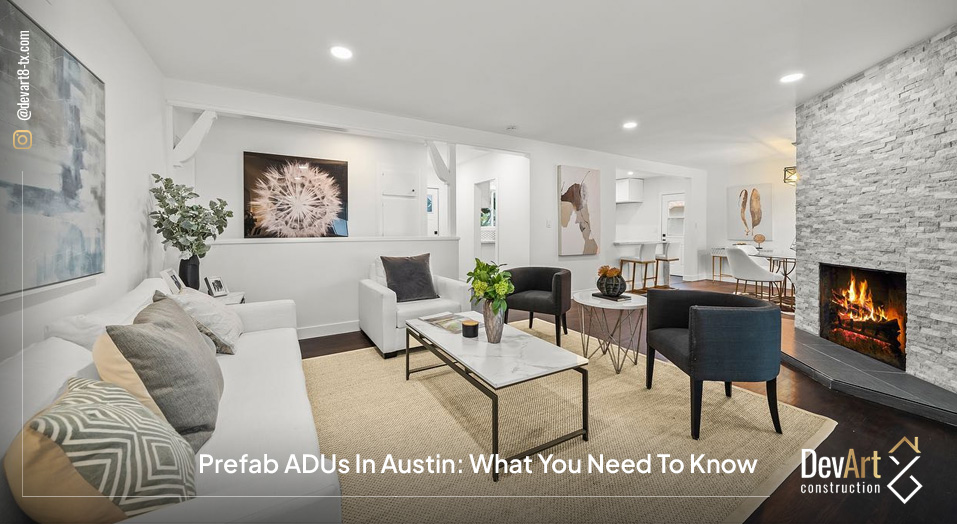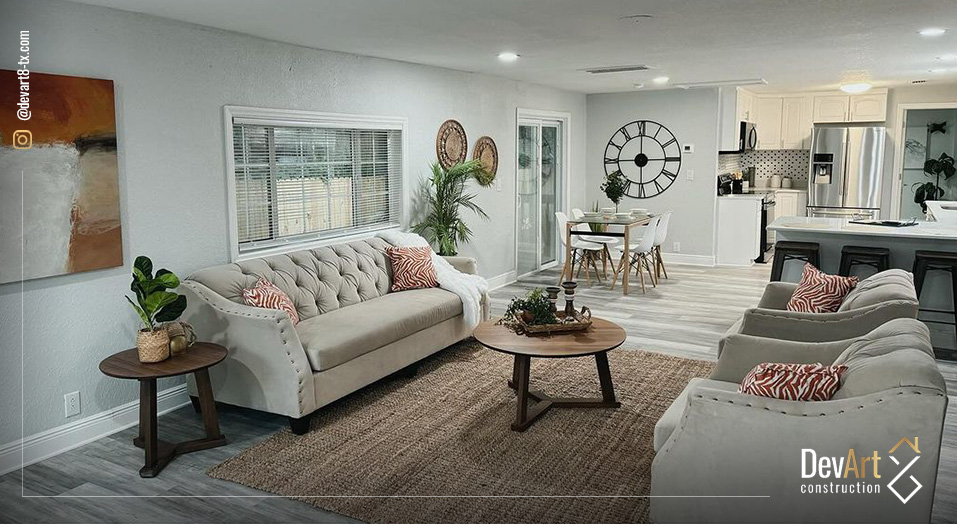To maximize living space and increase property value, homeowners are turning to innovative solutions like Prefabricated Accessory Dwelling Units (ADUs). Our comprehensive guide delves into the nuts and bolts of ADUs, demystifying this popular home addition trend.
DevArt8 Construction, with its expertise in customized construction, offers you the insights and services needed to effortlessly navigate the complexities of adding an ADU to your property. Whether you’re looking to create a guest house or a rental space or simply need an extra room, our guide, paired with DevArt8’s construction proficiency, ensures you make informed decisions at every step.

What Is a Prefab ADU?
Prefab ADUs, or Prefabricated Accessory Dwelling Units, are secondary living spaces constructed off-site and delivered to your property. They offer efficiency, cost-effectiveness, and strict quality control. These smaller units can be used for various purposes, such as housing aging parents or generating rental income. They enhance property value and provide innovative solutions for maximizing living space.
Types of Prefab ADUs
Prefab ADUs offer various types to meet individual needs. Standalone units provide maximum privacy, attached units ensure easy accessibility and interior units offer an economical space optimization solution. Choose the type that suits you best!
Modular Prefabs
Offers a unique blend of customization and convenience. Constructed in sections or modules within a controlled factory environment, they provide high-quality builds with a quicker turnaround time. Each module is built to exact specifications, ensuring precision and efficiency. Once completed, these units are transported to your property and assembled on-site to create a complete dwelling unit. This method reduces construction noise, debris, and disruption on your property.
Panelized Prefabs
Contrasting the modular design, Panelized Prefabs provide another flexible option for potential homeowners. These units are constructed from pre-made walls or panels fabricated off-site and then shipped to the property for assembly. The panels can be quickly erected on-site to form the structure of the dwelling unit while allowing more flexibility for interior design and layout adjustments. This makes them an ideal choice for those looking to customize their living spaces without sacrificing the convenience of prefabricated units.
Permits and Regulations for Prefab ADUs in Austin
Prefabricated Accessory Dwelling Units (ADU) offer a quicker and more efficient way to add living space to your Austin property. However, before diving in, it’s crucial to understand the city’s specific permits and regulations for these structures. Here’s a breakdown of what you need to know:
General Permits and Size Restrictions:
- Building Permit: You’ll need a standard building permit for your prefab ADU, just like any other construction project. This involves submitting plans, meeting building codes, and passing inspections.
- Size Limitations: Austin restricts ADU size to a maximum of 1,100 square feet or 15% of your lot size, whichever is smaller. Additionally, the total building coverage on your property can be at most 40%.
- Height Restrictions: Your ADU cannot be taller than 30 feet and can only have two stories, with the second being a maximum of 550 square feet.
Additional Considerations for Prefab ADUs:
- Prefabrication Approval: The prefabricated unit must meet national building standards and potentially undergo additional state approvals, depending on the manufacturer.
- Foundation and Installation: Ensure your chosen prefab builder is licensed and familiar with Austin’s installation requirements, including foundation specifications and wind zone regulations.
- Site Considerations: Even with a prefab unit, you must comply with setback requirements, utility connections, and accessibility guidelines.
Additional Notes:
- As of October 2021, Austin City Council is exploring ways to streamline the ADU permitting process and make these units more accessible. Stay informed about potential changes through the city’s official channels.
- Short-term rentals of ADUs are limited to 30 days per year in Austin. Long-term rentals are allowed.
City of Austin Housing and Planning Department provides detailed information on ADU regulations, including a helpful guide and online application system. For information on manufactured housing licensing and installation requirements, visit the Texas Department of Licensing and Regulation.
It’s highly recommended to consult with an architect, builder, and permit expeditor familiar with Austin’s ADU regulations to ensure a smooth and compliant project.
What Are the Benefits of a Prefab ADU?
Lower cost
Prefabricated units are built efficiently in factories, reducing waste and labor costs. They also eliminate unpredictable weather delays and simplify permitting processes, minimizing expenses.
This factory-controlled environment ensures consistent quality and adherence to building codes, potentially reducing the need for costly rework. Although transportation adds to the equation, the streamlined process and minimized disruption at your property can lead to significant cost savings compared to traditional construction.
Predictable timeline
Unlike traditional ADUs that face weather delays, material shortages, and unpredictable labor availability, prefab options offer a refreshingly predictable timeline. Since the units are constructed indoors in controlled environments, the weather doesn’t impact progress, and streamlined factory processes ensure consistent production speed.
This means you can move in much sooner, often within just a few months after permits are approved. Additionally, prefabrication allows site work like foundation preparation to occur simultaneously with factory construction, further compressing the overall timeline.
Minimal disruption
Prefab ADUs minimize disruption to your daily life in a big way. Since most of the construction happens off-site in a controlled factory, you’ll experience minimal noise, dust, and mess at your property. Imagine no constant hammering, lumber deliveries, or construction vehicles blocking your driveway.
Instead, your prefabricated ADU arrives mostly complete, ready for swift installation on your prepared foundation. This streamlined process typically takes just a few weeks, leaving your daily routine largely undisturbed and your property neat throughout the project.
Dependable high quality
Unlike traditional, on-site construction, where quality can vary depending on individual builders and crews, prefab ADUs offer reassuring consistency and high quality. Every component is meticulously crafted in controlled factory settings, adhering to strict quality control measures and standardized building codes.
This eliminates the risk of uneven craftsmanship, material inconsistencies, or weather-related damage plaguing traditional builds. Additionally, prefab manufacturers typically use high-grade, pre-inspected materials, further ensuring the overall durability and longevity of your ADU. S
Easier process
Unlike traditional ADU construction with lengthy timelines and onsite disruptions, prefab ADUs offer a significantly easier process. Imagine this: the main structure is manufactured off-site in a controlled environment, ensuring quality and efficiency.
Once ready, it’s delivered to your property and assembled like a giant Lego set, minimizing construction noise and mess. This streamlined approach typically shaves months off the process, with site prep and installation usually taking just weeks.
On top of the speed, prefab construction often comes with cost savings due to bulk purchasing and efficient labor practices.

Can a Prefab Adu Be Used as a Legal Dwelling?
Yes, in most cases, a prefab ADU (Accessory Dwelling Unit) can be used as a legal dwelling, but there are some important things to consider:
Building Code Compliance:
- Prefab ADUs must meet your area’s local building codes and zoning regulations. This means the unit’s size, structure, plumbing, electrical, and other aspects must comply with these standards.
- Reputable prefab ADU companies typically design their models to meet the building code requirements of the areas they serve. However, it’s crucial to double-check with your local building department to confirm that the specific model you’re interested in meets the regulations.
Permitting:
- Obtaining the necessary permits is crucial for any construction project, including prefab ADUs. This process involves submitting plans, paying fees, and potentially undergoing inspections.
- The permitting process can vary depending on your location, so it’s essential to consult with your local building department to understand the specific requirements and timeline.
Other Considerations:
- Foundation: Prefab ADUs typically require a permanent foundation, even though they are pre-built. This foundation must also comply with local building codes.
- Utilities: Ensure the ADU can be connected to the necessary utilities like water, sewer, and electricity. This may involve additional costs and permits.
- Homeowner’s Association (HOA) Rules: If you live in a community with an HOA, check their regulations regarding ADUs. Some HOAs may have restrictions on size, location, or design.
How Big Can Prefab Adus Be?
Prefab ADUs can vary greatly in size, depending on the specific needs of the homeowner and local building regulations. Generally, they range from as small as 200 square feet to as large as 1,200 square feet.
Smaller units function well as home offices or guest bedrooms, while larger ones can comfortably accommodate a small family with multiple bedrooms and full-sized kitchens and bathrooms. However, it’s important to note that local zoning laws may regulate the size of your ADU.
These laws specify minimum and maximum sizes for ADUs, so homeowners must check these details before planning their prefab ADU project. Despite these regulations, prefab ADUs offer ample opportunity for customization to ensure your new space meets your unique needs and preferences.
Conclusion
Prefab ADUs emerge as a compelling choice for those looking to expand their living space with efficiency, quality, and minimal disturbance. They offer a modern solution to traditional space expansion challenges with streamlined construction processes, adherence to high-quality standards, and the flexibility to meet various legal dwelling requirements. Whether you’re eyeing a cozy home office or a fully-equipped living quarters for relatives, navigating the local regulations and working with reputable companies is essential. By doing so, you can make the most of the benefits of prefab ADUs, ensuring your addiction is not just a swift build but a lasting investment in your property’s value and utility. As housing needs continue to evolve, prefab ADUs stand out as a smart, sustainable choice for the future of home expansion.




